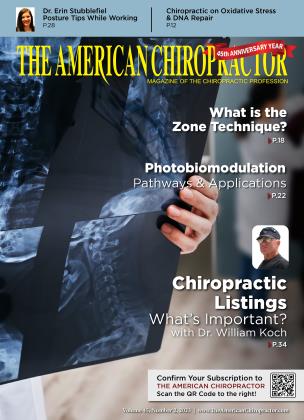Spine Management Report™
IN BRIEF
Chiropractic Management of Persistent Pain After Spine Surgery
William Owens
DC, DAAMLP, CPC
A team approach to the management of spine pain both the short and long term is gaining more credibility. In a recent paper by Chu et al. (2022), the authors sought to study the effects of chiropractic care on persistent pain after spine surgery. They stated, “The term ‘persistent spinal pain syndrome type 2’ (PSPS-2) has been proposed by the International Association for the Study of Pain to replace the term ‘failed back surgery syndrome.’ This retrospective study aimed to evaluate the effectiveness of multimodal care featuring chiropractic spinal manipulation (CSMT) in 31 adults in Hong Kong with PSPS-2.” (ps The paper stated, “Persistent spinal pain syndrome (PSPS) is a new term proposed by the International Association for the Study of Pain to define chronic or recurrent pain of spinal origin and replaces older, potentially pejorative terms such as ‘failed back surgery.’ PSPS is divided into type 1 (no previous surgery) and type 2 (relevant previous surgery; PSPS-2), which affects 20% to 40% of patients who have had spine surgery.” (pg 1} Understanding the source of the patient’s persistent pain is important, particularly if surgery did not address an undiagnosed mechanical component.
In terms of chiropractic, the authors reported, “Chiropractors are portal-of-entry providers that most often treat low back pain (LBP). Spinal manipulation is an evidence-based therapy recommended by several practice guidelines for LBP. However, few large-scale studies have explored the effectiveness of CSMT for PSPS-2, with the majority of evidence derived from case reports and series.” (ps ^This paper is important since it focused on a segment of the patient population that often struggles with finding solutions to persistent pain. Although the sample size is small, the results are positive.
The paper concluded by stating, “We found that adult patients with PSPS-2 showed improvement with multimodal chiropractic care featuring CSMT, which was more effective in patients who were younger, had a shorter duration of symptoms, and/or had a higher level of pain or disability before treatment.”(pg 12) Working with a doctor of chiropractic who is proficient in communicating with the surgical team, clinical documentation, and examination is critical for this patient population.
Dr. William Owens Jr is currently in private practice in Buffalo, NY. His practice employees 4 Doctors of Chiropractic and 2 Doctors of Physical Therapy. He is President and CEO of the National Spine Management Group, LLC and Clinical Director of the Fellowship in Spinal Biomechanics and Trauma. Additionally, Dr. Owens is Adjunct Faculty in Family Medicine at the State University of New York at Buffalo Jacobs School of Medicine and Cleveland University Kansas City, College of Chiropractic. He can be reached at 716.228.3847.
Reference
1. Chu, E.C.P., & Trctger, R. J. (2022). Effectiveness of Multimodal Chiropractic Care Featuring Spinal Manipulation for Persistent Spinal Pain Syndrome Following Lumbar Spine Surgery: Retrospective Chart Review of 31 Adults in Hong Kong. Medical Science Monitor: International Medical Journal of Experimental and Clinical Research. 28, e937640-1.
 View Full Issue
View Full Issue






